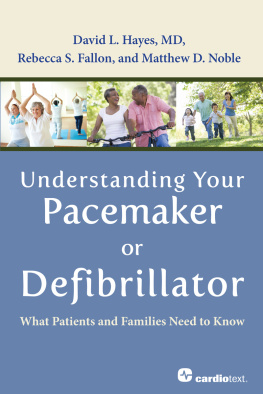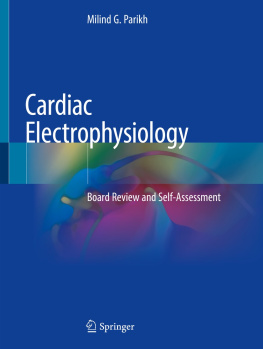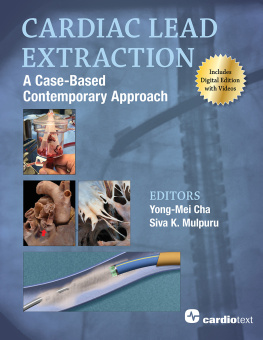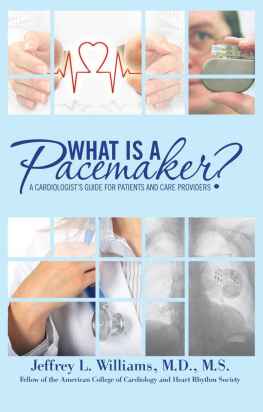Acknowledgments

The authors acknowledge colleagues who assisted in critical review of this text:
- Jodie Alwin, MBA
- Monica Boege, RN
- Rosemary Horsman, RN
- Marjorie Martin, RN
- Brian Powell, MD
- Melissa Rott, RN
- Samuel F. Sears, PhD
- Wayne M. Sotile, PhD
- Tracy Webster, RN
Appendix 1

Patient Resources Online
Patient Education Websites
American Heart Association
http://www.heart.org/HEARTORG/
Heart Rhythm Society
http://www.hrsonline.org/PatientInfo/
Device Manufacturer Websites
Biotronik
http://www.biotronik.com/wps/wcm/connect/en_us_web/biotronik/sub_top/patients/
503-635-3594
Boston Scientific
http://www.bostonscientific.com/home.bsci
800-227-3422
Medtronic
http://www.medtronic.com/health-consumers/index.htm
800-328-2518
St. Jude Medical
http://health.sjm.com/
800-328-9634
Sorin
http://www.sorin.com/anatomy
877-663-7674
Appendix 2

Understanding Abbreviations for Devices
You and your family will likely hear your healthcare providers talk in abbreviations as they talk about the type of device and/or how the device is programmed. These abbreviations may sound like somewhat of an alphabet soup the first time you hear them. The following terms should help you understand some fairly straightforward abbreviations that may otherwise seem mysterious.
DEVICE ABBREVIATIONS
PMpacemaker
ICDimplantable cardioverter defibrillator
CRTcardiac resynchronization therapy
CRT-PCRT device with only pacing therapy
CRT-DCRT device with an ICD incorporated
PACING MODE DESIGNATIONS
A code is used to describe different types of pacemakers or, more accurately, how an individual pacemaker is currently programmed. This code has been used for many years and consists of four letters. For example, the pacemaker in your device may be programmed DDDR.
What Do the Letters Mean?
The first letter is for the chamber paced. If only the ventricle is paced, the first letter will be V. If only the atrium is paced, the first letter is A. If both chambers are paced, the first letter is D.
The second letter indicates how the pacemaker responds to the heart's native rhythm. It's usually important that the pacemaker be able to detect your natural heartbeat so that it only works when needed. Again, if the pacemaker senses ventricular activity, the letter V is used; if atrial activity is sensed, the letter A is used. If the pacemaker is sensing or watching your cardiac activity from both chambers, using a dual-chamber system, a D is used.
The third letter describes how the device responds when the patient's own heart activity is sensed. When your own heart activity is sensed and the pacemaker temporarily stops pacing, the letter I is used. If the patient's natural heartbeat results in the pacemaker putting out an impulse, the letter T is used. (This setting is almost never used in a single-chamber pacemaker.) If you have a dual-chamber device, the letter D may sometimes appear. This letter is used when activity in both your heart's atrium and ventricle inhibits the pacemaker (shown as an I, meaning inhibited) and your intrinsic atrial activity also stimulates the lower chamber.
The fourth letter indicates whether the pacemaker can alter the pacing rate based on your activity. If the device is capable of this, the letter R appears in the fourth position, indicating that the pacemaker is rateresponsive. In other words, it is capable of adjusting your heart rate in response to your activity. If the pacemaker is not programmed to be rate responsive, the fourth position is left blank. Most devices do have this rate-responsiveness or rate-adaptation capability that can be turned on as needed. When this setting is turned on, the pacemaker will change the rate at which it paces your heart based on your activity, movement, and/or breathing rate and depth of breaths taken. For example, if you are sitting quietly or sleeping, and breathing normally, the pacemaker will only pace at the lowest rate setting. If you then start to move around and start breathing faster and deeper, the pacemaker will detect your activity and increase the pacing rate appropriately.
Some Examples
- A pacemaker that can pace and sense the upper chamber (atrium) only, is inhibited by your heart's atrial activity, and does not respond to changes in activity of some type = AAI
- A pacemaker that can pace and sense the lower chamber (ventricle) only, is inhibited by your own atrial activity, and does respond to changes in activity of some type = VVIR
- A pacemaker that can pace and sense in both the upper and lower chambers, is inhibited by your own activity in both chambers, can pace or stimulate the lower chamber whenever it senses activity in your upper chamber, and does respond to changes in activity of some type = DDDR
A FINAL NOTE
Many clinicians often will use these codes as a type of shorthand as well. Instead of saying dual-chamber pacemaker, they may simply say DDD pacer. Or they may call a single-chamber pacemaker a VVI device. Although this way of speaking is not necessarily accurate, as a VVI device could be a dual- or single-chamber system programmed to the VVI setting, this slang is often used nonetheless.
Chapter 1

Normal and Abnormal Heart Function
Learning more about the heart's normal structure and anatomy may help you understand why different heart problems occur and the conditions that may lead to the need for an implanted device.
BASIC CONCEPTS OF CARDIAC BLOOD FLOW
The heart is often described in terms of two concepts: plumbing and electrical. The heart is, by definition, a pump. There are four chambers in the heart ().
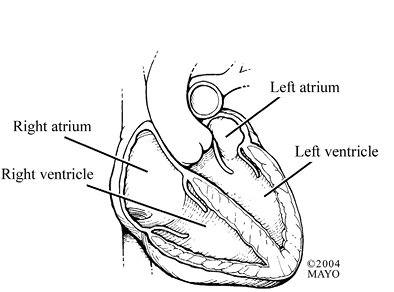
Figure 1. Normal heart.
The two chambers on the top are the atria (singular: atrium), and the two bottom chambers are the ventricles. Although every part of the heart is important, the left ventricle is responsible for pumping blood throughout the body, and it therefore plays a vital role in blood circulation. ). The blood leaving the left ventricle is rich with oxygen, which the rest of your body needs to stay healthy. As the blood goes through the aorta to other arteries and progressively smaller blood vessels, some of the oxygen in the blood leaves the red blood cells to nourish the body's tissues. The oxygen-poor blood then enters the veins and is routed back to the right side of the heart.
The blood enters the right atrium and then passes through a valve called the tricuspid valve into the right ventricle. When the right ventricle contracts or squeezes, the blood travels through the
Next page
